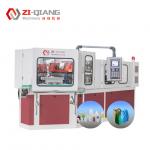A. Process integration • Advantages of one-step molding: It
integrates injection molding of preforms and blow molding of
containers. There is no need to manufacture preforms separately,
which reduces intermediate links (such as preform handling and
secondary heating) and improves production continuity. • High
precision: The injection molding process can accurately control the
size and wall thickness of the preform. The preform is evenly
heated during blow molding, and the size error of the finished
product is small (such as more regular details such as bottle mouth
thread and bottle body curvature).
B. Production efficiency and automation • High-speed mass
production: Some models can realize the "injection molding-blow
molding-demolding" cycle automation with a short cycle (such as
producing dozens of containers per minute), which is suitable for
large-scale industrial production. • Reduce manual intervention:
The entire process from raw material input to finished product
output is automated, reducing labor costs and reducing human
operation errors.
C. Product quality characteristics • Wall thickness uniformity:
During the blow molding process, the air pressure acts evenly on
the preform, and the wall thickness of the finished product is more
evenly distributed (such as beverage bottles, cosmetic bottles,
etc.), with better strength and sealing. • Surface finish: The
injection mold has high precision, and the surface of the product
after blow molding is smooth, without obvious parting lines or
burrs, which is suitable for products with high appearance
requirements (such as transparent packaging bottles). • High
material utilization rate: The parison is directly blow-molded,
with less waste. Compared with the traditional step-by-step process
(such as extrusion blow molding), the loss of raw materials is
reduced by 10%-20%.
D. Equipment adaptability and flexibility • Multi-specification
production: By replacing the mold and adjusting the process
parameters (such as injection pressure, blow molding air pressure),
containers with different capacities (from a few milliliters to
several liters) and shapes (round bottles, square bottles,
special-shaped bottles) can be produced. • Material compatibility:
It is suitable for thermoplastics such as polyethylene (PE),
polypropylene (PP), and polyethylene terephthalate (PET), meeting
the packaging needs of the food, medicine, daily chemical and other
industries.
E. Energy consumption and cost • Energy consumption is concentrated
and optimized: The heat energy in the injection and blow molding
process can be partially recycled (such as the waste heat of the
parison is used for blow molding heating), which reduces the energy
consumption of step-by-step equipment by about 15%. • High initial
investment: The equipment structure is complex (including injection
molding system, blow molding mold frame, hydraulic/pneumatic
system, etc.), and the purchase cost is higher than that of
single-function equipment, but long-term mass production can dilute
the cost.
F. Targeted application scenarios • Suitable for high-precision
requirements: such as medicine bottles (need to be sterile and
tightly sealed), cosmetic bottles (high appearance requirements),
food packaging bottles (leakage prevention), etc. • Not suitable
for oversized or overly complex structures: Limited by the size of
injection and blow molding molds, it is difficult to produce
oversized containers (such as industrial barrels) or products with
extremely complex structures










